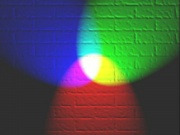Additive color process
Description
A system of color production used in color televisions, film, and monitors. Color synthesis is obtained by the addition of colors in the form of light rather than as reflected colorants on paper. For a typical three color process, an original image is separated into three monochrome images, or primaries, composed varying shades of red, green and blue; the combination of which can be used to produce all colors. A reproduced color image may be done by overlapping projection of the three monochrome images or by the viewing monochrome images printed as finely divided and slightly juxtaposed dots. The colors are mixed as a person's visual perception integrates the dots. Color televisions and color monitors use the additive color process. When 100% of all the three primaries, red, green and blue, are added together, the resultant image is white. If no light is present, the result is black. Combining 100% of two primaries results in a subtractive primary color:
- red and green = yellow
- red and blue = magenta
- green and blue = cyan
See also Subtractive color process.
Synonyms and Related Terms
additive primary (red, green and blue); RGB; Additives Farbverfahren (Deut.); aditivní míchání barev (Ces.); Additive Farbsynthese (Deut.); synthèse additive (Fr.); mescolanza additiva (It.); additieve kleurmenging (Ned.); sistema de color aditivo (Esp.); Additiv färgblandning (Sven.)
Authority
- Luis Nadeau, Encyclopedia of Printing, Photographic, and Photomechanical Processes, Atelier, New Brunswick, 1997
- Wikipedia, the free encyclopedia, at http://www.wikipedia.com Comment: http://en.wikipedia.org/wiki/Additive_color (Accessed Feb. 2, 2006)
